Design
The Stenka class (Project 205P) is a variant of the Osa-class missile boat (Project 205). The Stenkas used the hull of the Osa class and had a slightly larger crew. The development office of the Almaz Shipyard in Leningrad used the standardized components of the Osa class, in order to develop an anti-submarine warfare (ASW) boat. The anti-ship missile launch containers were replaced by four torpedo tubes but the anti-ship missile related structures and equipment were retained. The living spaces in the Stenkas were improved for long patrol endurance by raising the superstructure in order to create more usable space inside, compared to the Osa class. They also installed a more powerful air conditioner. [3]
The drive system is three diesel radial engines of the Zvezda M503 or M504 series with a total capacity of 12,000 metric horsepower (11,800 hp ) or 15,000 metric horsepower (14,800 hp).
Armament
The primary anti-submarine weapon for destroying submarines were SET-40 torpedoes. The boats have four 400 mm (16 in) torpedo tubes installed on the deck in the aft part of the boats, two on the port side and two on starboard side.
Behind the torpedo tubes on the aft deck, in the port and starboard sides, are each one depth charge rack. Twelve depth charges, six for each rack can be carried.
As the Osa-class boats (Project 205), the Stenka-class boats (Project 205P) has two radar-controlled 30 mm AK-230 guns in twin mounts, one in the bow, the other at the rear.
One of the boats was tested with a 57 mm AK-725 gun on the bow and received a modified project number – 205PE. [4]
Sensors
The 4Ts-30-125 or later MR-220 (NATO reporting name "Peel Cone") radar is a shipboard air and surface search radar mounted on the mast with two antennas for the friend or foe identification system ("High Pole B"). The MR-104 ("Drum Tilt") fire-control radar is mounted on the rear of the superstructure for directing the fire of the two AK-230 guns. The MG-345 Bronza submarine search system on the ships consists of the MG-329 Sheksna dipping sonar with the MG-11 Tamir-11 sonar sensor mounted in the hull.
This page is based on this
Wikipedia article Text is available under the
CC BY-SA 4.0 license; additional terms may apply.
Images, videos and audio are available under their respective licenses.


